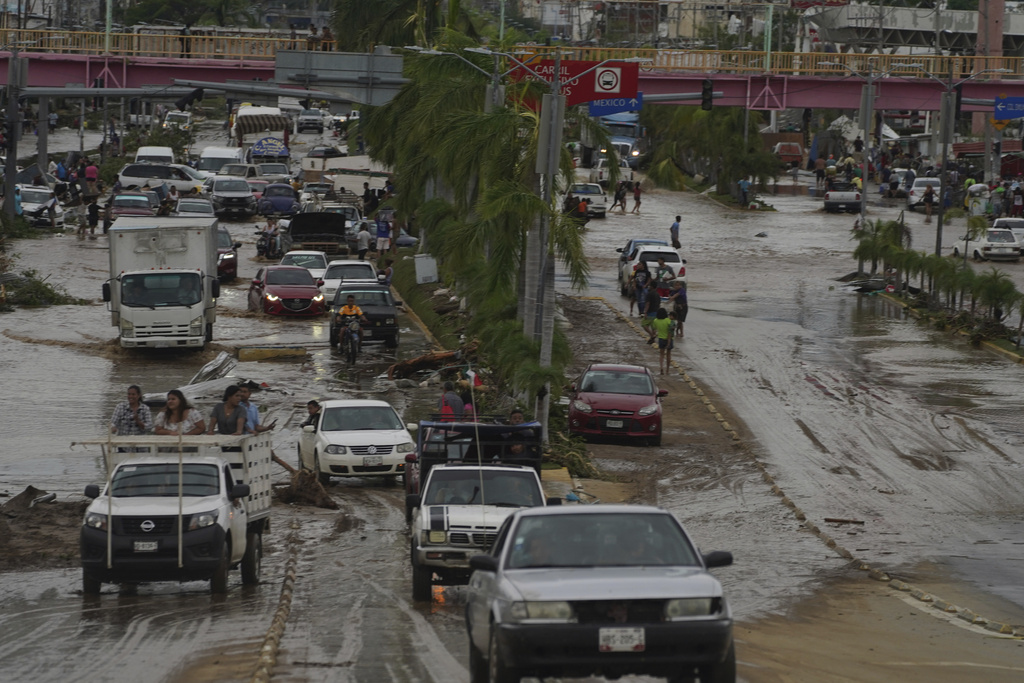Mexican authorities on Thursday gave the first human toll for Hurricane Otis’ destruction along the country’s Pacific coast: at least 27 dead and four missing.
Tens of thousands of residents in damaged homes without electricity awaited help more than a day after Otis roared ashore in Acapulco. The municipal water system wasn’t functioning, because there was no electricity to run the pumps.
President Andrés Manuel López Obrador said at his morning news briefing that the deaths occurred around Acapulco, but provided few details. He acknowledged that the government was late in arriving because of the havoc Otis left behind.
López Obrador, who made it into Acapulco late Wednesday, said the destruction was so complete in the impact zone that not a single power line pole remained standing. Outside the city, small farmers had their corn crops devastated by Otis’ wind and pounding rain, he said. Restoring power to the area was a top priority, he said.
“We regret the 27 dead,” López Obrador said. The president said Wednesday night that he had been told that the toll was 18, but it rose early Thursday.
“That’s what hurts the most,” he said of the deaths, noting material losses could be replaced. “The people sheltered, protected themselves and that’s why fortunately there weren’t more tragedies, loss of human life,” López Obrador said.
López Obrador shared details of only one death: He said one soldier was among the dead after a wall of his home collapsed on him.
The early images and accounts were of extensive devastation, toppled trees and power lines lying in brown floodwaters that in some areas extended for miles. The resulting destruction delayed a comprehensive response by the government, which was still assessing the damage along the coast, and made residents desperate.
Many of the once sleek beachfront hotels in Acapulco looked like toothless, shattered hulks after the Category 5 storm blew out hundreds — and possibly thousands — of windows.
There seemed to be a widespread frustration with authorities. While around 10,000 military troops were deployed to the area, they lacked the tools to clean tons of mud and fallen trees from the streets. Hundreds of trucks from the government electricity company arrived in Acapulco early Wednesday, but seemed at a loss as to how to restore power, with downed electricity lines lying in feet of mud and water.
Jakob Sauczuk was staying with a group of friends at a beachfront hotel when Otis hit.
“We laid down on the floor, and some between beds,” Sauczuk said. “We prayed a lot.”
One of his friends showed reporters photos of the windowless, shattered rooms in the hotel. It looked as if someone had put clothes, beds and furniture in a blender, leaving a shredded mass.
Sauczuk complained that his group was given no warning, nor were offered safer shelter, by the hotel.
Pablo Navarro, an auto parts worker who was lodged in temporary accommodations at a beachfront hotel, thought he might die in his 13th-story hotel room.
“I took shelter in the bathroom, and thankfully the door held,” said Navarro. “But there were some rooms where the wind blew out the windows and the doors.”
Navarro stood Wednesday outside a discount grocery and household goods store near the hotel zone, as hundreds of people wrestled everything — from packs of hot dogs and toilet paper to flat screen televisions — out of the muddy store, struggling to push loaded metal shopping carts onto the mud-choked streets outside.
“This is out of control,” he said.
Isabel de la Cruz, a resident of Acapulco, tried to move a shopping cart loaded with diapers, instant noodles and toilet paper through the mud.
She viewed what she took as a chance to help her family after she lost the tin roof of her home and her family’s important documents in the hurricane.
“When is the government ever going to look after the common people?” she said.
Inside one store, National Guard officers allowed looters to take perishable items like food, but made futile efforts to prevent people from taking appliances, even as people outside loaded refrigerators on top of taxis.
It took nearly all day Wednesday for authorities to partially reopen the main highway connecting Acapulco to the state capital Chilpancingo and Mexico City. The vital ground link allowed dozens of emergency vehicles, personnel and trucks carrying supplies to reach the battered port.
Acapulco’s commercial and military airports were still too badly damaged to resume flights.
Acapulco’s Diamond Zone, an oceanfront area replete with hotels, restaurants and other tourist attractions, looked to be mostly underwater in drone footage that Foro TV posted online Wednesday afternoon, with boulevards and bridges completely hidden by an enormous lake of brown water.
Large buildings had their walls and roofs partially or completely ripped off. Dislodged solar panels, cars and debris littered the lobby of one severely damaged hotel. People wandered up to their waists in water in some areas, while on other less-flooded streets, soldiers shoveled rubble and fallen palm fronds from the pavement.
The city plunged into darkness on Wednesday night.
On Tuesday, Otis took many by surprise when it rapidly strengthened from a tropical storm to a powerful Category 5 hurricane as it tore along the coast.
“It’s one thing to have a Category 5 hurricane make landfall somewhere when you’re expecting it or expecting a strong hurricane, but to have it happen when you’re not expecting anything to happen is truly a nightmare,” said Brian McNoldy, a hurricane researcher at the University of Miami.
Acapulco is at the foot of steep mountains. Luxury homes and slums alike cover the hillsides with views of the glistening Pacific Ocean. Once drawing Hollywood stars for its nightlife, sport fishing and cliff diving shows, the port has in recent years fallen victim to competing organized crime groups that have sunk the city into violence, driving many international tourists to the Caribbean waters of Cancun and the Riviera Maya or beaches farther down the Pacific coast in the state of Oaxaca.
López Obrador noted that Otis was a stronger hurricane than Pauline, which hit Acapulco in 1997, destroying swaths of the city and killing more than 300 people.
(AP)











